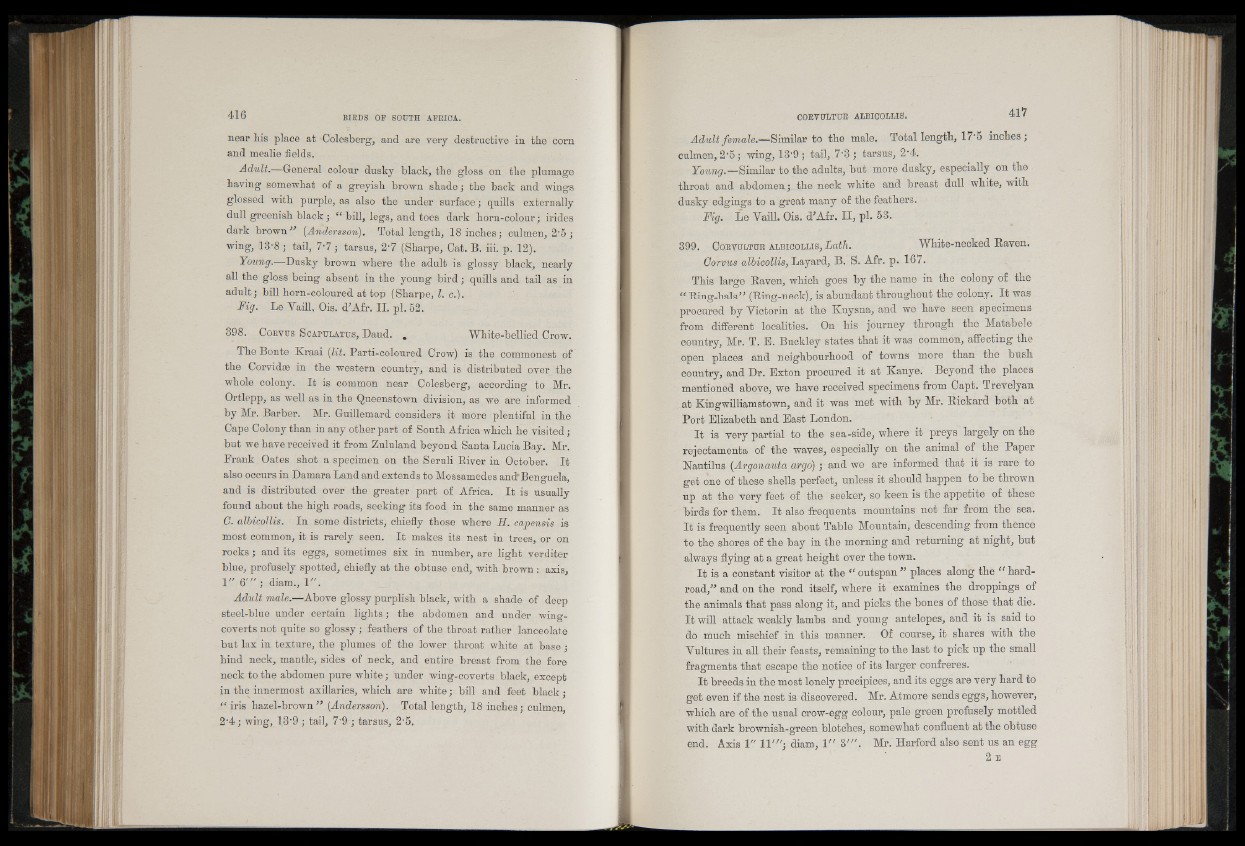
near his place at Colesberg, and are very destructive in the corn
and mealie fields.
Adult.—General colour dusky black, the gloss on the plumage
having somewhat of a greyish brown shade; the back and wings
glossed with purple, as also the under surface; quills externally
dull greenish black; “ bill, legs, and toes dark horn-colour; irides
dark brown” (Andersson). Total length, 18 inches; culmen, 2*5;
wing, 13-8; tail, 7*7; tarsus, 2'7 (Sharpe, Cat. B. iii. p. 12).
Young.—Dusky brown where the adult is glossy black, nearly
all the gloss being absent in the young bird; quills and tail as in
adult; bill horn-coloured at top (Sharpe, I. c.).
Fig. Le Yaill, Ois. d'Afr. II. pi. 52.
398. C orvus S capulatus, Daud. . W hite-bellied Crow.
The Bonte Kraai (lit. Parti-coloured Crow) is the commonest of
the Corvidae in the western country, and is distributed over the
whole colony. It is common near Colesberg, according to Mr.
Ortlepp, as well as in the Queenstown division, as we are informed
by Mr. Barber. Mr. Guillemard considers it more plentiful in the
Cape Colony than in any other part of South Africa which he visited;
but we have received it from Zululand beyond Santa Lucia Bay. Mr.
Frank Oates shot a specimen on the Seruli River in October. It
also occurs in Damara Land and extends to Mossamedes and’BengO- uela*
and is distributed over the greater part of Africa. It is usually
found about the high roads, seeking its food in the same manner as
G. albicollis. In some districts, chiefly those where H. capensis is
most common, it is rarely seen. It makes its nest in trees, or on
rocks; and its eggs, sometimes six in number, are light verditer
blue, profusely spotted, chiefly at the obtuse end, with brown : axis,
1" &" ; diam., 1".
Adult male.—Above glossy purplish black, with a shade of deep
steel-blue under certain lights; the abdomen and under wing-
coverts not quite so glossy; feathers of the throat rather lanceolate
but lax in texture, the plumes of the lower throat white at base;
hind neck, mantle, sides of neck, and entire breast from the fore
neck to the abdomen pure white; under wing-coverts black, except
in the innermost axillaries, which are white; bill and feet black;
“ iris hazel-brown” (Andersson). Total length, 18 inches; culmen,
2*4; wing, 13*9 ; tail, 7’9 ; tarsus, 2-5.
Adult female.—Similar to the male. Total length, 17*5 inches;
Culmen, 2*5; wing, 13*9 ; tail, .7*3; tarsus, 2*4.
Young.—Similar to the adults, but more dusky, especially on the
throat and abdomen; the neck white and breast dull white, with
dusky edgings to a great many of the feathers.
Fig. Le Yaill. Ois. d'Afr. II, pi. 53.
399. Oorvultur alb ico llis , Lath. White-necked Raven.
Oorvus albicollis, Layard, B. S. Afr. p. 167.
This large Raven, which goes by the name in the colony of the
“ Ring-hals” (Ring-neck), is abundant throughout the colony. I t was
procured by Yictorin at the Knysna, and we have seen specimens
from different localities. On his journey through the Matabele
country, Mr. T. E. Buckley states that it was common, affecting the
open places and neighbourhood of towns more than the bush
country, and Dr. Exton procured it at Kanye. Beyond the places
mentioned above, we have received specimens from Capt. Trevelyan
at Kingwilliamstown, and it was met with by Mr. Rickard both at
Port Elizabeth and East London.
It is very partial to the sea-side, where it preys largely on the
rejectamenta of the waves, especially on the animal of the Paper
Nautilus (Argonauta argo) ; and we are informed that it is rare to
get one of these shells perfect, unless it should happen to be thrown
up at the very feet of the seeker, so keen is the appetite of these
birds for them. I t also frequents mountains not far from the sea.
It is frequently seen about Table Mountain, descending from thence
to the shores of the bay in the morning and returning at night, but
always flying at a great height over the town.
I t is a constant visitor at the “ outspan ” places along the “ hard-
road,” and on the road itself, where it examines the droppings of
the animals that pass along it, and picks the bones of those that die.
It will attack weakly lambs and young antelopes, and it is said to
do much mischief in this manner. Of course, it shares with the
Yultures in all their feasts, remaining to the last to pick up the small
fragments that escape the notice of its larger confreres.
I t breeds in the most lonely precipices, and its eggs are very hard to
get even if the nest is discovered. Mr. Atmore sends eggs, however,
which are of the usual crow-egg colour, pale green profusely mottled
with dark brownish-green blotches, somewhat confluent at the obtuse
end. Axis 1" 11'"; diam, 1" 3 '". Mr. Harford also sent us an egg
2 E